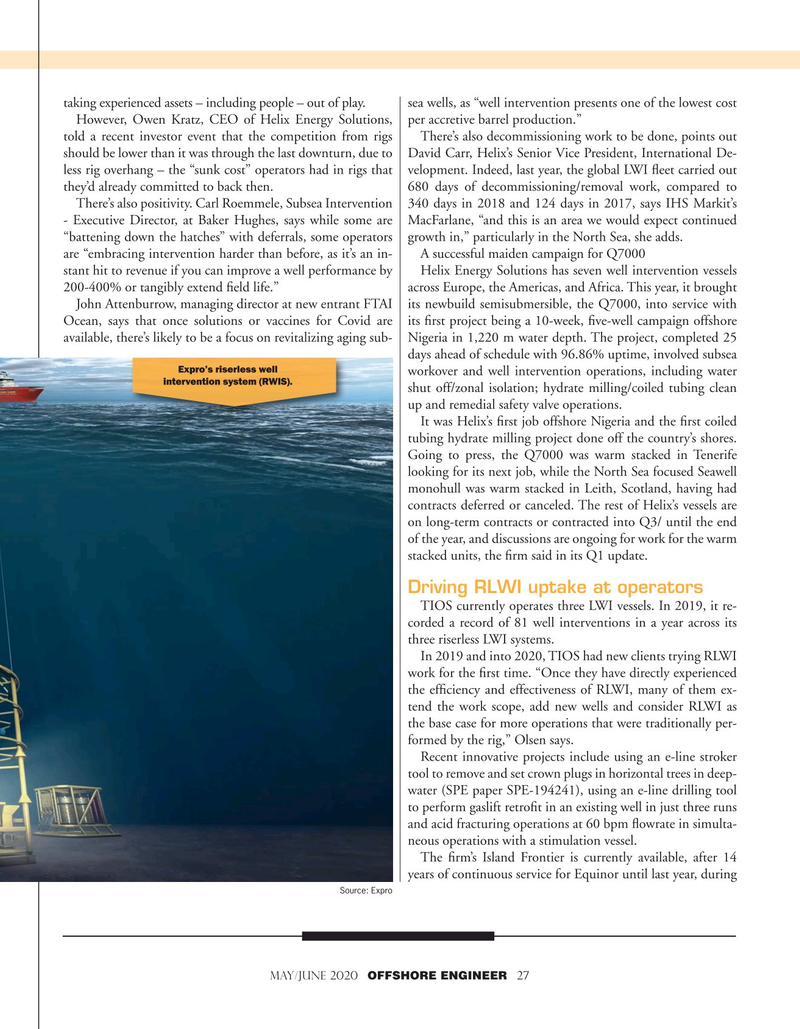
Page 27: of Offshore Engineer Magazine (May/Jun 2020)
Read this page in Pdf, Flash or Html5 edition of May/Jun 2020 Offshore Engineer Magazine
taking experienced assets – including people – out of play. sea wells, as “well intervention presents one of the lowest cost
However, Owen Kratz, CEO of Helix Energy Solutions, per accretive barrel production.” told a recent investor event that the competition from rigs There’s also decommissioning work to be done, points out should be lower than it was through the last downturn, due to David Carr, Helix’s Senior Vice President, International De- less rig overhang – the “sunk cost” operators had in rigs that velopment. Indeed, last year, the global LWI feet carried out they’d already committed to back then. 680 days of decommissioning/removal work, compared to
There’s also positivity. Carl Roemmele, Subsea Intervention 340 days in 2018 and 124 days in 2017, says IHS Markit’s - Executive Director, at Baker Hughes, says while some are MacFarlane, “and this is an area we would expect continued “battening down the hatches” with deferrals, some operators growth in,” particularly in the North Sea, she adds. are “embracing intervention harder than before, as it’s an in- A successful maiden campaign for Q7000 stant hit to revenue if you can improve a well performance by Helix Energy Solutions has seven well intervention vessels 200-400% or tangibly extend feld life.” across Europe, the Americas, and Africa. This year, it brought
John Attenburrow, managing director at new entrant FTAI its newbuild semisubmersible, the Q7000, into service with
Ocean, says that once solutions or vaccines for Covid are its frst project being a 10-week, fve-well campaign offshore available, there’s likely to be a focus on revitalizing aging sub- Nigeria in 1,220 m water depth. The project, completed 25 days ahead of schedule with 96.86% uptime, involved subsea
Expro’s riserless well workover and well intervention operations, including water intervention system (RWIS).
shut off/zonal isolation; hydrate milling/coiled tubing clean up and remedial safety valve operations.
It was Helix’s frst job offshore Nigeria and the frst coiled tubing hydrate milling project done off the country’s shores.
Going to press, the Q7000 was warm stacked in Tenerife looking for its next job, while the North Sea focused Seawell monohull was warm stacked in Leith, Scotland, having had contracts deferred or canceled. The rest of Helix’s vessels are on long-term contracts or contracted into Q3/ until the end of the year, and discussions are ongoing for work for the warm stacked units, the frm said in its Q1 update.
Driving RLWI uptake at operators
TIOS currently operates three LWI vessels. In 2019, it re- corded a record of 81 well interventions in a year across its three riserless LWI systems.
In 2019 and into 2020, TIOS had new clients trying RLWI work for the frst time. “Once they have directly experienced the effciency and effectiveness of RLWI, many of them ex- tend the work scope, add new wells and consider RLWI as the base case for more operations that were traditionally per- formed by the rig,” Olsen says.
Recent innovative projects include using an e-line stroker tool to remove and set crown plugs in horizontal trees in deep- water (SPE paper SPE-194241), using an e-line drilling tool to perform gaslift retroft in an existing well in just three runs and acid fracturing operations at 60 bpm fowrate in simulta- neous operations with a stimulation vessel.
The frm’s Island Frontier is currently available, after 14 years of continuous service for Equinor until last year, during
Source: Expro
MAY/JUNE 2020 OFFSHORE ENGINEER 27

 26
26

 28
28